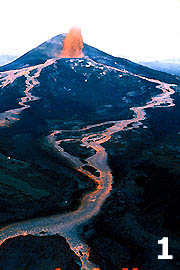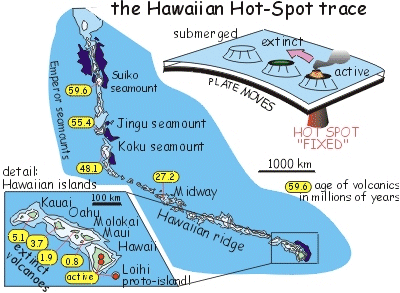|
The Hawaiian Islands
|
On the younger Hawaiian islands, volcanism is very active, while on the older islands, volcanoes are extinct. Let's have a look at the young island Hawaii, where several active volcanoes are situated: (1) Volcanic eruption Puu Oo at volcano Kilauea on the island Hawaii in 1986. Photographer: J.D. Griggs, USGS (2) Lava fountain of the volcanic eruption Puu OO at volcano Kilauea in 1986. Photographer: J.D. Griggs, USGS (3) Lava, cooling down, looking like a mudflow. Photographer: B. Jenny (4) Since the fresh volcanic rock is very fertile, the first plants colonize the lava fields not long after the eruption. Photographer: B. Jenny |
| |
|
Why volcanism on Hawaii? Although most volcanic activity is concentrated at plate boundaries, volcanoes can also occur within plates and form high mountains. An example is the island chain that begins with the active volcanoes on Hawaii and continues as a string of progressively older, extinct, eroded and submerged volcanic ridges and mountains. What is the explanation for volcano and mountain building in the middle of a plate? Hot spots are proposed as the surface manifestation of jets or plumes of hot material that rise from deep within the mantle, drill through the lithosphere and emerge as volcanic centers. These currents are supposedly fixed in the mantle and seem not to move with the plates. As a result, the hot spot leaves a trail of progressively older volcanoes as the plate moves over it. If these long-lived hot spots are indeed fixed in the mantle, the trail of volcanoes carried away from the hot spot provides an effective method of measuring the velocity and direction of plate motion. The chain of the Hawaiian islands does not lie in one row, but shows that the direction of the plate movement must have changed in earlier times. |
|
|
|
|
Watch the volcanoes on Hawaii The latest news from the Hawaiian Volcano Observatory |
|||
|
|

